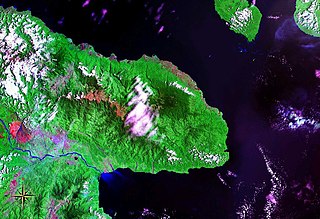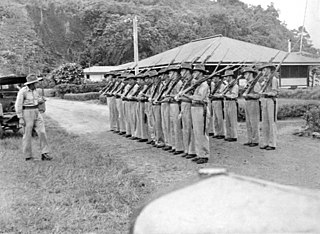
The prehistory of Papua New Guinea can be traced to about 50,000–60,000 years ago, when people first migrated towards the Australian continent. The written history began when European navigators first sighted New Guinea in the early part of the 17th century.

Transport in Papua New Guinea is mainly based around roads and air travel. It is in many cases heavily limited by the mountainous terrain and copious amount of rainfall and frequent severe weather occurring in many locations, such as Lae. The capital, Port Moresby, is not linked by road to any of the other major towns and many highland villages can only be reached by light aircraft or on foot.

Lae (German: Preußen-Reede, later Lehe) is the capital of Morobe Province and is the second-largest city in Papua New Guinea. It is located near the delta of the Markham River on the northern coast of Huon Gulf. It is at the start of the Highlands Highway, which is the main land transport corridor between the Highlands Region and the coast. Lae is the largest cargo port of the country and is the industrial hub of Papua New Guinea. The city is known as the Garden City and home of the Papua New Guinea University of Technology.

For administrative purposes, Papua New Guinea is divided into administrative divisions called provinces. There are 22 provincial-level divisions, which include 20 provinces, the Autonomous Region of Bougainville, and the National Capital District of Port Moresby.

Morobe Province is a province on the northern coast of Papua New Guinea. The provincial capital and largest city is Lae. The province covers 33,705 km2, with a population of 674,810, and since the division of Southern Highlands Province in May 2012 it is the most populous province. It includes the Huon Peninsula, the Markham River, and delta, and coastal territories along the Huon Gulf. The province has nine administrative districts. At least 101 languages are spoken, including Kâte and Yabem language. English and Tok Pisin are common languages in the urban areas, and in some areas pidgin forms of German are mixed with the native language.

Huon Peninsula is a large rugged peninsula on the island of New Guinea in Morobe Province, eastern Papua New Guinea. It is named after French explorer Jean-Michel Huon de Kermadec. The peninsula is dominated by the steep Saruwaged and Finisterre and Cromwell Mountains. The nearest large town is the Morobe provincial capital Lae to the south, while settlements on the north coast include the former German town of Finschhafen, the district capital of Wasu, Malalamai and Saidor with its World War II era Saidor Airport.

Mining in Papua New Guinea is an important part of the Papua New Guinea economy.

Momase Region is one of four regions of Papua New Guinea. Its largest city is Lae, the second city of the nation. The name Momase is a portmanteau of the constituent provinces, Morobe, Madang and Sepik. Momase is by far the most linguistically diverse region of Papua New Guinea.

The New Guinea Volunteer Rifles (NGVR) was an infantry battalion of the Australian Army. It was initially raised as a unit of the Militia from white Australian and European expatriates in New Guinea upon the outbreak of the Second World War in 1939, before being activated for full-time service following the Japanese landings in early 1942. NGVR personnel then helped rescue survivors of Lark Force from Rabaul in February and March 1942. Between March and May, the NGVR monitored the Japanese bases which had been established in the Huon Gulf region, being the only Allied force in the area until the arrival of Kanga Force at Wau in May. The battalion subsequently established observation posts overlooking the main approaches and reported on Japanese movements.

The Australian New Guinea Administrative Unit (ANGAU) was a civil administration of Territory of Papua and the Mandated Territory of New Guinea formed on 21 March 1942 during World War II. The civil administration of both Papua and the Mandated Territory of New Guinea were replaced by an Australian Army military government and came under the control of ANGAU from February 1942 until the end of World War II.
The Papua New Guinea cholera outbreak was an outbreak of cholera along the Northern Coast of Papua New Guinea. It was the country's first outbreak of cholera in 50 years, and spread across the country from two coastal villages near Lae to villages around MAdang and to remote areas along the Sepik River.

The Papua New Guinea National Soccer League is the men's top division of professional soccer in Papua New Guinea. It is a nationwide league formed in 2006 by Papua New Guinea Football Association.
Chinatown is a suburb of Lae in the Morobe Province, Papua New Guinea.
Eriku is a suburb of Lae in the Morobe Province, Papua New Guinea.

As the township of Lae, in Morobe Province, Papua New Guinea is a relatively new entity, the history of the Lae environs is much older.
The following lists events that happened in 2014 in Papua New Guinea.
The 2018 Papua New Guinea National Soccer League was the 12th edition of Papua New Guinea National Soccer League. The league ran from 13 January to 26 May 2018.
Sarah Haoda Todd is an entrepreneur, fashion designer and activist from Lae, Papua New Guinea.
On 11 September 2022, an earthquake of moment magnitude 7.6–7.7 struck Papua New Guinea, in the northern part of Morobe Province. The normal faulting earthquake occurred with a hypocenter depth of 116.0 km (72.1 mi) beneath the Finisterre Range. A maximum perceived Modified Mercalli intensity of VIII (Severe) was estimated. Shaking was widely felt across the country and even in neighbouring Indonesia. At least 21 people died and 42 were injured, mostly due to landslides.













